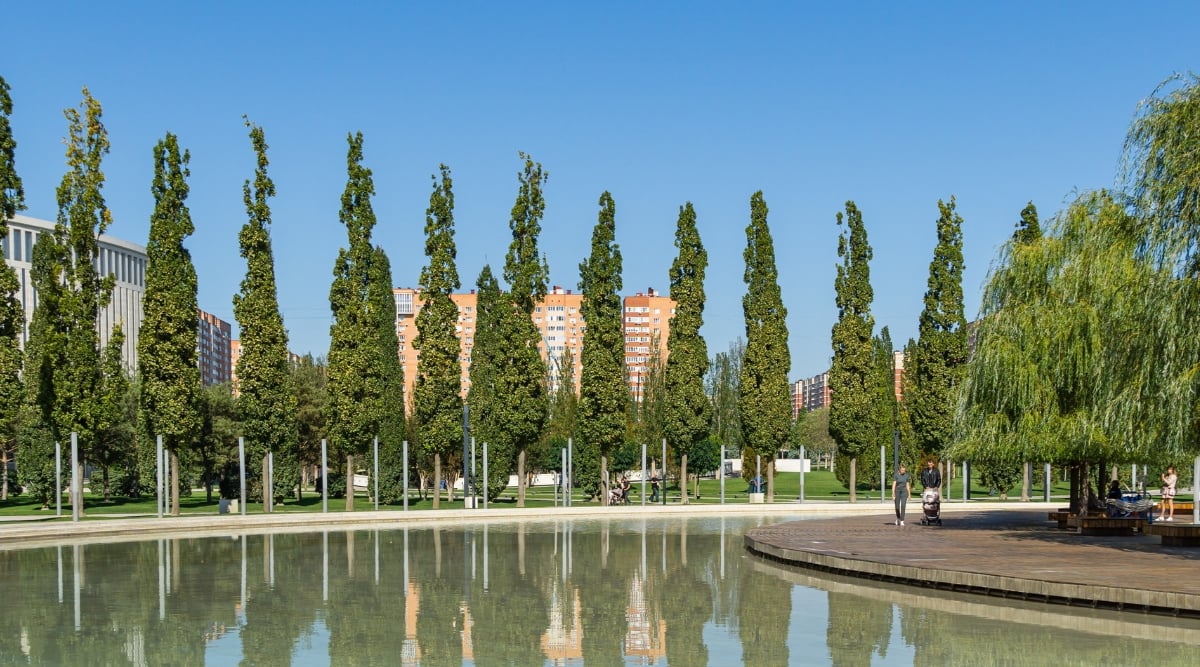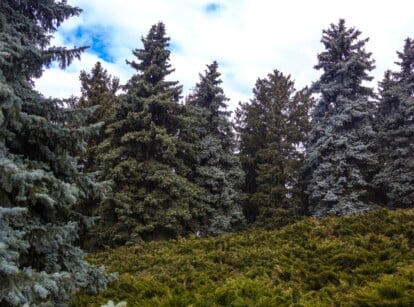9 Arborvitae Alternatives for Your Landscape
Do you want a tree or shrub that has the look of an arborvitae but without the many issues these plants can have? Several options may fit your landscape. Gardening expert Melissa Strauss offers alternatives to arborvitae that will look beautiful with fewer vulnerabilities

Contents
Arborvitaes are attractive, evergreen large shrubs and medium-sized trees. Their symmetrical, pyramidal, or conical shapes make them popular landscape elements. With the right care and conditions, they can be wonderful. Sadly, owners of these plants tend to encounter a lot of issues trying to keep them healthy. Fortunately, several other species can be sturdy alternatives with a similar appearance.
When looking for alternatives to arborvitaes, there are a few considerations to make. Some noteworthy and desirable characteristics of this group of plants include their evergreen nature and pleasing shape. Before we jump into these alternatives, let’s talk about a few of the issues that you may run into with an arborvitae.
What’s the Problem?

Arborvitaes can be pretty fussy when it comes to their care. They have poor drought tolerance, so if you’re not big on watering your established trees, they can be high maintenance. If the soil dries out for too long, your plant may start dropping needles, leaving it looking pretty sad. Too much water is not good either, so striking that balance is important. They can also be susceptible to winter burn.
There are quite a number of pests and diseases that seem to disproportionately affect these trees and shrubs. Fungal diseases are particularly problematic in arborvitaes compared to alternative plants. From spider mites and scales to leaf miners and bagworms, there are plenty of pests that like to feed on them.
As high-maintenance as they are, arborvitaes are still attractive plants if you can keep up with their substantial needs. However, if you would prefer something a little less high maintenance, there are options to consider that may better suit your needs.
Juniper ‘Blue Arrow’

|
|
common name Juniper ‘Blue Arrow’ |
|---|---|
|
|
botanical name Juniperus scopulorum ‘Blue Arrow’ |
|
|
sun requirements Full sun |
|
|
height 10’-15’ |
|
|
hardiness zones 4-9 |
If the issue you’re most concerned with is drought tolerance, juniper may be a good arborvitae alternative for your landscape. Though they are not much more disease or pest-resistant, they can handle dry weather with more grace and vitality. ‘Blue Arrow’ is a compact juniper that reaches about 15 feet tall at maturity. A row of these makes an excellent wind or privacy screen.
‘Blue Arrow’ juniper has lovely, blue-green, aromatic foliage. It is adaptable to a wide range of soil types and has excellent cold tolerance. As far north as zone 9, you’re unlikely to have any winter burn issues. This tree’s extensive root system makes it efficient at drawing water from the soil. Make sure it has proper drainage to keep it looking its best.
Dwarf Italian Cypress ‘Tiny Tower’

|
|
common name Dwarf Italian Cypress ‘Tiny Tower’ |
|---|---|
|
|
botanical name Cupressus sempervirens ‘Monshel’ |
|
|
sun requirements Full sun |
|
|
height 25’-30’ |
|
|
hardiness zones 7-10 |
Arborvitae is fairly heat tolerant but not compared to Italian cypress trees. ‘Tiny Tower’ is a dwarf variety that thrives as far south as zone 10. Its tidy, columnar growth habit is very low maintenance. You won’t have to worry about pruning this tree. Although it tends to be rather narrow, it’s a wonderful addition to the garden.
The blue-green foliage is small and dense on this attractive cultivar. It needs a significant amount of water in its first season but will be drought-tolerant once established. This is a slow-growing tree that will ultimately mature to a substantial 25-30 feet tall. It’s also virtually pest and disease-free.
Irish Yew ‘Fastigiata Aurea’

|
|
common name Irish Yew ‘Fastigiata Aurea’ |
|---|---|
|
|
botanical name Taxus baccata ‘Fastigata Aurea’ |
|
|
sun requirements Full sun to partial shade |
|
|
height 4’-30’ |
|
|
hardiness zones 7-8 |
Yew trees are symbolic of rebirth for a very sensible reason. These pretty evergreens are very resilient and long-lived. If your yew tree becomes overgrown and unruly, you can hard prune it back to nearly the bare trunk, and it will recover beautifully. Some are commonly trained to be large shrubs or topiaries. Golden Irish yew or ‘Fastigiata Aurea’ has more of a columnar growth habit.
Other qualities of yew trees include pretty evergreen foliage and bright red fruits. These can be highly decorative and take well to pruning. While they are more high-maintenance than some others on the list, they have plenty of positive qualities. Their resilience is remarkable, and they are exceptionally long-lived. Once established, they are drought tolerant.
Juniper ‘Taylor’

|
|
common name Juniper ‘Taylor’ |
|---|---|
|
|
botanical name Juniperus virginiana ‘Taylor’ |
|
|
sun requirements Full sun |
|
|
height Up to 20’ |
|
|
hardiness zones 4-9 |
‘Taylor’ juniper has all the wonderful characteristics of its family members. The attractive blue-green foliage has a soft and feathery appearance. This variety has an elegant, upright growth habit that requires little maintenance. Fertilizer once a year is typically all you’ll need to offer.
Like other junipers, this one is flexible in terms of soil. As long as the soil is not overly wet, ‘Taylor’ will be happy. Water your tree during the first growing season. Once established, it should be drought-tolerant. This juniper is tolerant of cold and heat. With a range of zones 4-9, you can grow this tree almost anywhere!
Japanese Cedar ‘Sekkan-sugi’

|
|
common name Japanese Cedar ‘Sekkan-sugi’ |
|---|---|
|
|
botanical name Cryptomeria japonica ‘Sekkan-sugi’ |
|
|
sun requirements Full sun to partial shade |
|
|
height 10’-30’ |
|
|
hardiness zones 6-9 |
Japanese cedars have a reputation for being, generally, pest-and-disease-free. ‘Sekkan-sugi’ is a great arborvitae alternative if you don’t have time to worry about upkeep but you still want an appealing wind or privacy screen. This tree is on the smaller side, reaching 10′-30′ at maturity. It gets there quickly, putting on about a foot of growth per year. It’s flexible with soil, preferring moist, well-drained soil of any composition and pH.
This variety is a winner of the Award of Garden Merit from the Royal Horticultural Society. It grows in a soft, conical shape with lightly pendulous branches. The foliage has a slight weeping appearance, and new growth is a creamy, golden yellow. It gradually deepens to green over the summer. It can tolerate a range of exposures from full sun to partial shade.
Holly ‘Nellie R. Stevens’

|
|
common name Holly ‘Nellie R. Stevens’ |
|---|---|
|
|
botanical name Ilex x ‘Nellie R. Stevens’ |
|
|
sun requirements Full sun to partial shade |
|
|
height 15’-30’ |
|
|
hardiness zones 6-9 |
Holly trees are slightly different from the rest on this list. Their broad leaves set them apart from many other evergreens. They are a great replacement if you want something that provides privacy. The dense, glossy foliage is decorative and makes this tree an excellent windscreen, too.
‘Nellie R. Stevens’ is a mid-sized holly that tolerates full sun or partial shade. It prefers acidic soil, but it is otherwise adaptable. This tree has an attractive, conical growth habit and tolerates pruning if you like a manicured look. It produces beautiful, bright red berries, making this tree extra eye-catching.
Columnar English Oak ‘Fastigiata’

|
|
common name Columnar English Oak ‘Fastigiata’ |
|---|---|
|
|
botanical name Quercus robur ‘Fastigiata’ |
|
|
sun requirements Full sun |
|
|
height Up to 60’ |
|
|
hardiness zones 5-8 |
Columnar English oaks lack the evergreen nature of arborvitae, but they make a nice alternative landscape element all the same. If you want a larger tree, this is a great one to add to your yard. ‘Fastigata’ is a tall tree with glossy, green foliage that turns gold in the fall. The fall interest is a big draw for this tree. It is the only deciduous tree on the list.
English oak trees are not picky about soil, they tolerate a range of compositions and pH levels. They are low-maintenance trees with few issues. Powdery mildew can show up, but it’s otherwise pest and disease-resistant. They are salt tolerant and unbothered by urban pollution.
Arizona Cypress ‘Carolina Sapphire’

|
|
common name Arizona Cypress ‘Carolina Sapphire’ |
|---|---|
|
|
botanical name Hesperocyparis arizonica ‘Carolina Sapphire’ |
|
|
sun requirements Full sun |
|
|
height 25’-60’ |
|
|
hardiness zones 7-11 |
Arizona cypress is a great choice for warm climates because it is heat-and-drought-tolerant. It will retain its pretty, blue-green foliage all year and has a tendency to fill out faster than arborvitae. Generally, this fast growing tree reaches about 25-60 feet at maturity.
‘Carolina Sapphire’ has a strong silvery-blue cast to its foliage. It is pest and deer-resistant and establishes itself in the garden quickly. It doesn’t mind sandy soil and makes a beautiful privacy screen. For southern gardeners concerned about drought and heat tolerance, this is a wonderful choice.
Hinoki Cypress ‘Fernspray’

|
|
common name Hinoki Cypress ‘Fernspray’ |
|---|---|
|
|
botanical name Chamaecyparis obtusa ‘Filicoides’ |
|
|
sun requirements Full sun to partial shade |
|
|
height 10’-20’ |
|
|
hardiness zones 4-8 |
Hinoki cypress trees have a unique and beautiful growth habit that sets them apart. They fit the bill as far as being pyramidal in form but with an exotic flair. If you want a smaller cultivar, ‘Fernspray’ is perfect. It only reaches 10-20 feet at maturity, and you can prune it to keep it smaller.
Hinoki cypress has very few issues. They are pest and disease-resistant and don’t require any special care or maintenance. They are highly ornamental and eye-catching, adding beauty while performing as a perfect privacy screen. Their foliage is dense and decorative. They can be costly but have an exceptional lifespan and low-maintenance nature.
Key Takeaways
Arborvitaes are pretty plants with some undeniable qualities. They certainly have their place in the landscape if you want to put in the effort to keep them looking nice. If what you want is a low-maintenance wind or privacy screen, though, there are easier options.









